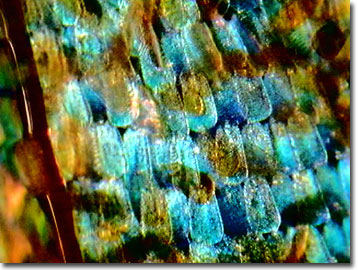Butterfly Wing Scale Digital Image Gallery
Silverspot Butterfly
The silverspot butterfly is an insect that goes by many names. Scientifically described as Dione juno, the butterflies are alternatively known as silver-spotted flambeaus and the larvae are often referred to as passion fruit caterpillars or hornworms. Physiological studies reveal that members of this butterfly species possess exceptionally keen eyesight and can learn to discriminate flowers rapidly based on color association, distinctly preferring those that are red or blue.

The silverspot butterflies range from southern California to the southern tip of South America. In flight, the butterflies flash the colors of burnt orange and black that covers the upper sides of their wings. At rest, their more cryptic wing undersides reveal a camouflage mosaic of brown, yellow, and orange, highlighted by several reflective silver wing panels. The species prefers to inhabit forest clearings and gathers nectar and pollen from plants in the genus Gurania.
Adult silverspot butterflies are not often alone. On the Caribbean Islands of Grenada, Martinique, and St. Vincent, the lepidopterans reportedly form colonies and roost together in the same trees night after night. Moreover, the silverspot butterfly is part of a mimicry ring, which includes about seven other butterfly species, representing five different genera. The silverspot and its mimics often fly together in mixed flocks for protection. Since predators cannot differentiate the similarly colored butterflies, only a few need to be sacrificed to predation for the greater good of the whole.
In its other life stages, the silverspot butterfly species also tends to be surrounded by others. Females lay their bright yellow eggs in large rafts composed of 60 to 130 eggs and when the gregarious larvae hatch, they remain in large groups, feeding together on passion vines and passionflowers. The caterpillars begin as small yellow creatures, but mature larvae have two short horns adorning their dark brown heads and light brown, mottled bodies covered with bristles. Despite their antagonistic appearance, silverspot caterpillars are not physically irritating, nor toxic to vertebrates. The caterpillars are, however, considered serious agricultural pests at passionflower and passion fruit farms in Costa Rica and Brazil.
Contributing Authors
Cynthia D. Kelly, Shannon H. Neaves, Laurence D. Zuckerman, and Michael W. Davidson - National High Magnetic Field Laboratory, 1800 East Paul Dirac Dr., The Florida State University, Tallahassee, Florida, 32310.
BACK TO THE BUTTERFLY WING SCALE IMAGE GALLERY
BACK TO THE DIGITAL IMAGE GALLERIES
Questions or comments? Send us an email.
© 1995-2025 by Michael W. Davidson and The Florida State University. All Rights Reserved. No images, graphics, software, scripts, or applets may be reproduced or used in any manner without permission from the copyright holders. Use of this website means you agree to all of the Legal Terms and Conditions set forth by the owners.
This website is maintained by our
Graphics & Web Programming Team
in collaboration with Optical Microscopy at the
National High Magnetic Field Laboratory.
Last Modification Friday, Nov 13, 2015 at 01:19 PM
Access Count Since January 21, 2003: 10645
Visit the website of our partner in introductory microscopy education:
|
|
